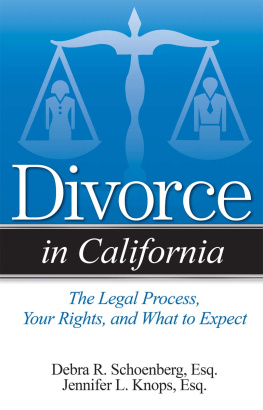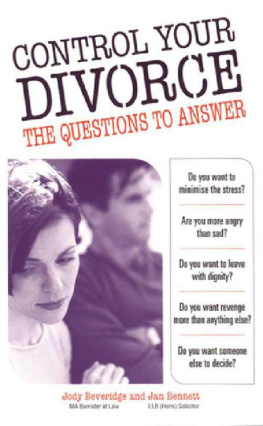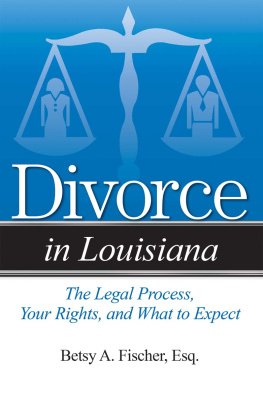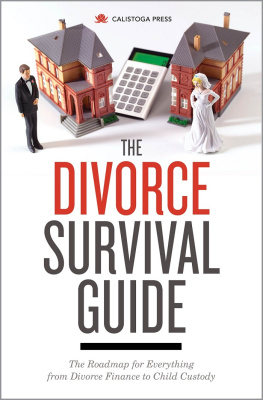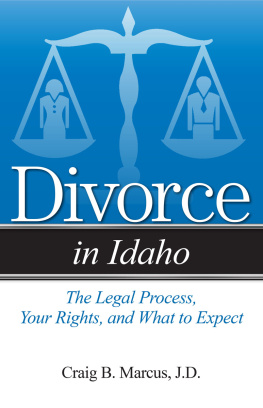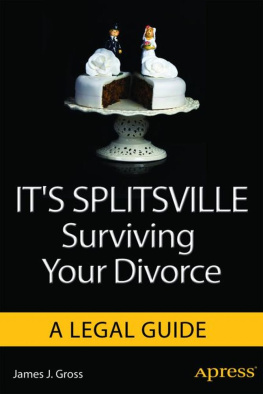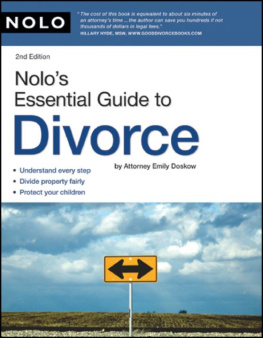John Brownrigg - Divorce: Making it Work Better
Here you can read online John Brownrigg - Divorce: Making it Work Better full text of the book (entire story) in english for free. Download pdf and epub, get meaning, cover and reviews about this ebook. year: 2013, publisher: Hornbeam Press, genre: Home and family. Description of the work, (preface) as well as reviews are available. Best literature library LitArk.com created for fans of good reading and offers a wide selection of genres:
Romance novel
Science fiction
Adventure
Detective
Science
History
Home and family
Prose
Art
Politics
Computer
Non-fiction
Religion
Business
Children
Humor
Choose a favorite category and find really read worthwhile books. Enjoy immersion in the world of imagination, feel the emotions of the characters or learn something new for yourself, make an fascinating discovery.
- Book:Divorce: Making it Work Better
- Author:
- Publisher:Hornbeam Press
- Genre:
- Year:2013
- Rating:5 / 5
- Favourites:Add to favourites
- Your mark:
- 100
- 1
- 2
- 3
- 4
- 5
Divorce: Making it Work Better: summary, description and annotation
We offer to read an annotation, description, summary or preface (depends on what the author of the book "Divorce: Making it Work Better" wrote himself). If you haven't found the necessary information about the book — write in the comments, we will try to find it.
Divorce: Making it Work Better — read online for free the complete book (whole text) full work
Below is the text of the book, divided by pages. System saving the place of the last page read, allows you to conveniently read the book "Divorce: Making it Work Better" online for free, without having to search again every time where you left off. Put a bookmark, and you can go to the page where you finished reading at any time.
Font size:
Interval:
Bookmark:

JOHN BROWNRIGG
Hornbeam Press
Copyright 2013 by John Brownrigg
The moral right of the author has been asserted
ISBN 978-0-9565236-6-2
Apart from any use permitted under UK copyright law, this publication may only be reproduced, stored or transmitted, in any form, or by any means, with prior permission in wrting of the publishers or, in the case of reprographice production, in accordance with the terms of licences issued by the Copyright Licensing Agency.
First published as an ebook in 2013 by the Hornbeam Press, 45 Falkland Road, London NW5 2XB
All names in the case histories have been changed.
John Brownrigg has been practising family law for 35 years and has been a partner at Stone King for 33 years. He is a solicitor, mediator, collaborative lawyer and arbitrator. He is a former Board Member of the Family Mediators Association and a member of Resolution. Legal 500, a directory of lawyers which contains the views of clients and the views of other lawyers in the same field, said of John Brownriggs team in 2013: The overall level of service is extremely high and well managed by Practice Head John Brownrigg who is highly recommended. It has also said that he provides calm and consistent advice and is kind and considerate. Chambers, another legal directory, places him and his team in its top category (Band 1) for family law and describes him as a popular figure who is also pragmatic, bright and thoughtful. He has had a keen interest in charities over the years, including the Samaritans and the Stonham Housing Association, Off The Record, and Mentoring Plus. John Brownrigg has been married (to the same woman) since 1980 and has three children, Tom, Jack and Anna.
This book is dedicated to the troubled children of parents who could not discover a constructive way through separation.
I am very grateful to five people whose encouragement and ability enabled the highly unlikely to happen: John Brownrigg writing a book on his approach to divorce law. They are Emma Dally, Jane Walker, Julie Sheppard, Caroline Fell, and above all Richard Ehrlich, whose capacity to interpret and ability to deliver as an editor has been remarkable.
I have been divorced over 100 times a year for the last 30 years. But only in a professional capacity, thank goodness. I am a divorce lawyer, and seeing several thousand people go through this painful process has given me a great deal of experience both of the process and of its human costs.
But I have also learned of the positive aspects. Divorce is never anything other than painful and difficult, but there are ways of lessening the pain. This book aims to explain how to do that, and to help you find your own way through with a minimum of suffering, conflict, and expense.
This is not a book about the law, though obviously the law plays an important part in it. It is not about legal statutes or dramatic cases fought by the super-rich. It is about how you can work towards finding your own solutions to your own problems on separation or divorce, even when you cannot see a way through the unknown. It is about giving you an opportunity to understand, control, and manage a major change in your life.
I feel a responsibility to educate and inform from my experience as a matrimonial lawyer and mediator, in the hope that better decisions can be made by separating couples who need to keep their head through one of the most stressful times of their life. It is always said that divorce is the second most difficult grieving event after the death of a loved one, with moving house in third place behind those two. When you think that divorce often requires one or both partners to move house, you can imagine just how devastating an effect it is likely to have. And its effects are long-lasting. Matrimonial fallout doesnt just involve the separating couple. It has a profound effect on the whole family, and especially on children. We all know children who have been unable to maintain communication with one or both parents when there has been conflict surrounding divorce. The family can be fractured if there is no attempt to work together at the time of separation. If you dont put a plaster cast on that fracture immediately, it will never mend. The fracture isnt caused by the divorce in itself. It is caused by the impact of conflict. And the fracture can repeat itself down the generations.
I hope that this book may help you avoid that fracture, to minimise conflict by taking control of your divorce. Do not behave in a way that removes your partner from your childrens lives. Do not behave in a way that will make your children see your partner in a bad light. Do not put your children in the middle of the conflict between the two of you, which means that your children feel they have to end up parenting their parents. Children almost always try to protect the parent whom they perceive to be weaker in the relationship and separation, or the parent whom they share their day-to-day life with. Whatever the details may be, it is unfair on your children and ultimately destructive for you, too.
And it is all avoidable, if you resolve to behave like grownups and carry through with your resolution.
Fact: Over 30 per cent of first marriages break down
Fact: Over 40 per cent of second and subsequent marriages break down
Fact: The majority of cohabitating relationships break down
Fact: Over one in every three children come from separated families
If you are going to join their number, I hope that this book will help make the process less bad for you and more constructive for your family. I have written it because Ive seen so much of the destruction that comes out of divorces conducted through conflict.
My focus has always been on constructive negotiation and mediation, rather than litigation and issuing proceedings through the courts. From the beginning, this approach to family law seemed to be different from my peers.
I always liked the idea of lawyers and clients meeting together in a room. I always liked the idea of discussing matters by telephone. I never understood the need for lawyers to posture in negotiations, write reams of paper, and issue proceedings that were not worth the money they cost. It always struck me that discussion could cut through misunderstanding.
I have also believed for many decades that people are generally well intentioned and trying to do the best they can in difficult circumstances. I therefore have been slow to be sceptical of peoples motives.
As a family lawyer, I am proud to say that only a very small percentage of my cases go to court. I would estimate that the percentage of my clients who issue proceedings to deal with the finances each year is well below 3 per cent of my caseload, substantially lower than that of my peers who have been keener to issue proceedings through the courts at an early stage when dealing with similar cases. Of course, I also recognise that some cases demand action through the courts because the two parties are not both prepared to come to the table and discuss matters.
At first, when I was pressing for meetings and discussions, particularly with clients present, a very small proportion of lawyers would take up my offer. They were more comfortable in taking a position on paper after having detailed discussions with their client, and trying to achieve for their client the very best outcome, regardless of its impact down the line.
Next pageFont size:
Interval:
Bookmark:
Similar books «Divorce: Making it Work Better»
Look at similar books to Divorce: Making it Work Better. We have selected literature similar in name and meaning in the hope of providing readers with more options to find new, interesting, not yet read works.
Discussion, reviews of the book Divorce: Making it Work Better and just readers' own opinions. Leave your comments, write what you think about the work, its meaning or the main characters. Specify what exactly you liked and what you didn't like, and why you think so.





